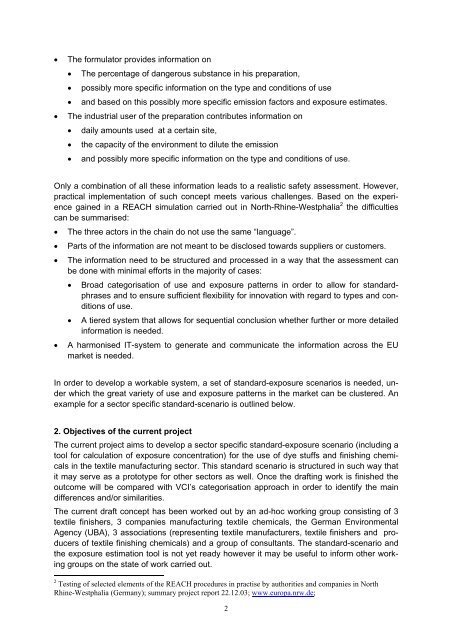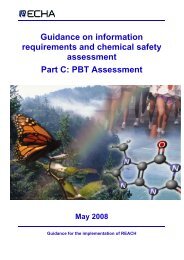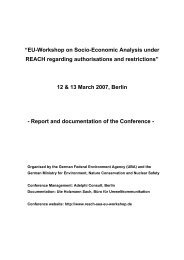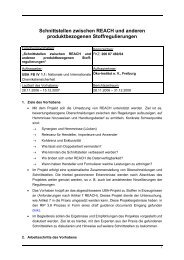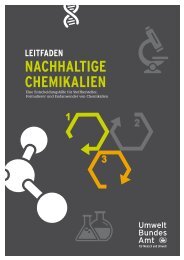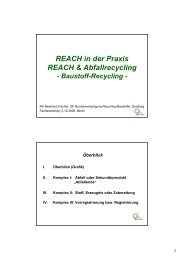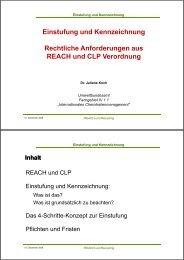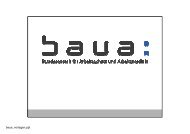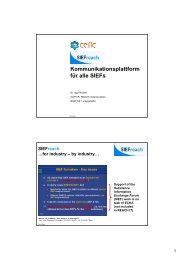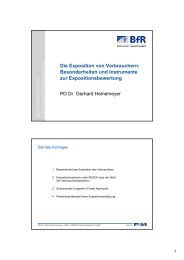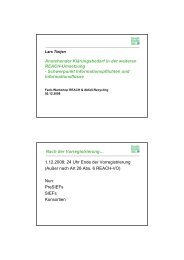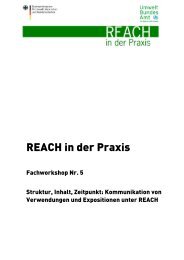Schlussbericht 2004-11-30 - REACh
Schlussbericht 2004-11-30 - REACh
Schlussbericht 2004-11-30 - REACh
Erfolgreiche ePaper selbst erstellen
Machen Sie aus Ihren PDF Publikationen ein blätterbares Flipbook mit unserer einzigartigen Google optimierten e-Paper Software.
• The formulator provides information on<br />
• The percentage of dangerous substance in his preparation,<br />
• possibly more specific information on the type and conditions of use<br />
• and based on this possibly more specific emission factors and exposure estimates.<br />
• The industrial user of the preparation contributes information on<br />
• daily amounts used at a certain site,<br />
• the capacity of the environment to dilute the emission<br />
• and possibly more specific information on the type and conditions of use.<br />
Only a combination of all these information leads to a realistic safety assessment. However,<br />
practical implementation of such concept meets various challenges. Based on the experience<br />
gained in a REACH simulation carried out in North-Rhine-Westphalia 2 the difficulties<br />
can be summarised:<br />
• The three actors in the chain do not use the same “language”.<br />
• Parts of the information are not meant to be disclosed towards suppliers or customers.<br />
• The information need to be structured and processed in a way that the assessment can<br />
be done with minimal efforts in the majority of cases:<br />
• Broad categorisation of use and exposure patterns in order to allow for standardphrases<br />
and to ensure sufficient flexibility for innovation with regard to types and conditions<br />
of use.<br />
• A tiered system that allows for sequential conclusion whether further or more detailed<br />
information is needed.<br />
• A harmonised IT-system to generate and communicate the information across the EU<br />
market is needed.<br />
In order to develop a workable system, a set of standard-exposure scenarios is needed, under<br />
which the great variety of use and exposure patterns in the market can be clustered. An<br />
example for a sector specific standard-scenario is outlined below.<br />
2. Objectives of the current project<br />
The current project aims to develop a sector specific standard-exposure scenario (including a<br />
tool for calculation of exposure concentration) for the use of dye stuffs and finishing chemicals<br />
in the textile manufacturing sector. This standard scenario is structured in such way that<br />
it may serve as a prototype for other sectors as well. Once the drafting work is finished the<br />
outcome will be compared with VCI’s categorisation approach in order to identify the main<br />
differences and/or similarities.<br />
The current draft concept has been worked out by an ad-hoc working group consisting of 3<br />
textile finishers, 3 companies manufacturing textile chemicals, the German Environmental<br />
Agency (UBA), 3 associations (representing textile manufacturers, textile finishers and producers<br />
of textile finishing chemicals) and a group of consultants. The standard-scenario and<br />
the exposure estimation tool is not yet ready however it may be useful to inform other working<br />
groups on the state of work carried out.<br />
2 Testing of selected elements of the REACH procedures in practise by authorities and companies in North<br />
Rhine-Westphalia (Germany); summary project report 22.12.03; www.europa.nrw.de;<br />
2


